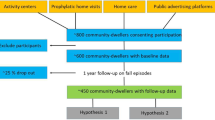Abstract
Background/Objectives
Falls are one of the most prevalent health issues facing older adults. This study examines the validity of the Toulouse-St. Louis University Mini Falls Assessment (TSLUMFA). Objectives were to validate the TSLUMFA by testing if it differentiates between prior non fallers (n=80) and fallers (n=23), and predicts future falls as well as or better than the gold standard Tinetti Gait and Balance Instrument (TGBI). Examine if the subset of FRAIL Scale items on the TSLUMFA distinguishes between previous non fallers (n=75) and fallers (n=20), and predicts future falls as well as or better than the TGBI. Identify TSLUMFA cut offs scores for fall risk.
Design
Prospective validation study.
Setting
Participants were ambulatory patients presenting to the SLU Geriatrics Clinic.
Participants
103 ambulatory older adults.
Measurements
Fall risk was assessed using the three assessments. Outcome measures were previous falls and follow up falls.
Results
TSLUMFA, FRAIL, and TGBI differentiated between previous fallers and non fallers. A TSLUMFA score <23 stratified patients as moderate risk (Sensitivity=0.806 Specificity=0.776) and a score <21 stratified patients as high risk (Sensitivity=0.929 Specificity=0.897). 78% of patients (n=80) participated in follow up and 20% (n=16) of these patients fell during follow up. TSLUMFA and TGBI absolute scores were lower among patients who fell during the follow up period versus non fallers but the observed differences were not statistically significant (TSLUMFA P=0.123 and TGBI P=0.074).
Conclusion
This study validated the TSLUMFA and FRAIL. No test predicted falls with statistical significance (most likely due to the low follow up participation) but a positive trend was seen. Clinical recommendations from this study are to use the FRAIL as an initial fall screen and patients scoring > 3 should be analyzed by TSLUMFA. The TSLUMFA’s advantage is that it pinpoints areas that will directly benefit from therapy to reduce falls.




Similar content being viewed by others
References
Rubenstein LZ. Falls in older people: epidemiology, risk factors and strategies for prevention. Age and Ageing. 2006;35:37–41.
Stevens JA. Falls among older adults -risk factors and prevention strategies. J Safety Res. 2005;36(4):409–411.
Baker SP, Harvey A. Fall injuries in the elderly. Clinics in geriatric medicine. 1985;1(3):501–512.
Murphy J, Isaacs B. The post-fall syndrome. Gerontology. 1982;28(4):265–270.
Vetter NJ, Ford D. Anxiety and depression scores in elderly fallers. International Journal of Geriatric Psychiatry. 1989;4(3):159–163.
Liddle J, Gilleard C. The emotional consequences of falls for patients and their families. Age Ageing. 1994;23(Suppl 4):17.
Oliver D, Hopper A, Seed P. Do hospital fall prevention programs work? A systematic review. Journal of the American Geriatrics Society. 2000;48(12):1679–1689.
Alexander BH, Rivara FP, Wolf ME. The Cost and Frequency of Hospitalization for Fall-Related Injuries in Older Adults. Am J Public Health. 1992;82(7):1020–1023.
Choi M, Hector M. Effectiveness of intervention programs in preventing falls: a systematic review of recent 10 years and meta-analysis. J Am Med Dir Assoc. 2012;13(2):188 e113–121.
Cameron ID, Murray GR, Gillespie LD, et al. Interventions for preventing falls in older people in nursing care facilities and hospitals. Cochrane Database Syst Rev. 2010(1):CD005465.
Morley JE, Rolland Y, Tolson D, Vellas B. Increasing awareness of the factors producing falls: the mini falls assessment. J Am Med Dir Assoc. 2012;13(2):87–90.
Gokce Kutsal Y, Barak A, Atalay A, et al. Polypharmacy in the elderly: a multicenter study. J Am Med Dir Assoc. 2009;10(7):486–490.
Graafmans WC, Ooms ME, Hofstee HM, Bezemer PD, Bouter LM, Lips P. Falls in the elderly: a prospective study of risk factors and risk profiles. Am J Epidemiol. 1996;143(11):1129–1136.
Malmstrom TK, Miller DK, Morley JE. A comparison of four frailty models. J Am Geriatr Soc. 2014;62(4):721–726.
Morley JE, Malmstrom TK, Miller DK. A simple frailty questionnaire (FRAIL) predicts outcomes in middle aged African Americans. J Nutr Health Aging. 2012;16(7):601–608.
Tinetti ME. Performance-oriented assessment of mobility problems in elderly patients. Journal of the American Geriatrics Society. 1986;34(2):119–126.
Vaught SL. Gait, balance, and fall prevention. Ochsner J. 2001;3(2):94–97.
Author information
Authors and Affiliations
Corresponding author
Rights and permissions
About this article
Cite this article
Rouck, J.E., Malmstrom, T.K. & Morley, J.E. Initial Validation of the Toulouse St. Louis University Mini Falls Assessment in Older Adults. J Nutr Health Aging 22, 880–884 (2018). https://doi.org/10.1007/s12603-018-1073-x
Received:
Accepted:
Published:
Issue Date:
DOI: https://doi.org/10.1007/s12603-018-1073-x




